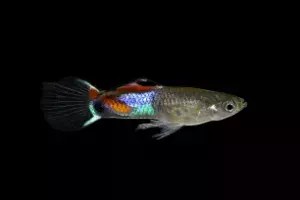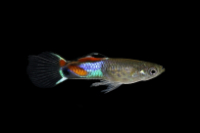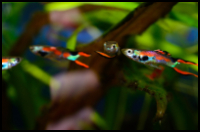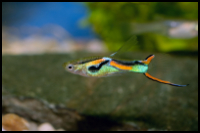





Quick Care Details (Table)
| Livestock Characteristics | Value |
|---|---|
| Care Level | Easy |
| Temperament | Peaceful |
| Diet | Omnivore |
| Maximum Size | 1.5 inches (3.8 cm) |
| Minimum Tank Size | 5 gallons |
| Plant Safe | Yes |
| Temperature Range | 72-82°F (22-28°C) |
| PH Range | 6.5-8.5 |
| KH Range | 5-20 dKH |
| GH Range | 10-30 dGH |
Species Specific Categories
Helpful Video
Care Details
Aquascape: Create a densely planted tank with open swimming areas for Endlers, utilizing floating plants to diffuse lighting.
Substrate: Fine gravel or sand suits their foraging habits, aiding in plant growth.
Disease Prevention: Regular water changes, a balanced diet, and quarantine for new fish help prevent common diseases.
Filtration: Efficient filtration is crucial; they appreciate gentle water flow.
Lighting: Moderate lighting suits their habitat; plants thrive, and it doesn't stress them.
Water Flow: Gentle currents mimic their natural freshwater environment.
Hardiness: They're hardy once acclimated to tank conditions.
Acclimation: Gradual acclimation to new water parameters eases stress.
Expected Lifespan: Endlers Typically 2-3 years, but can exceed in optimal conditions.
Special Requirements: They prefer stable water conditions and a varied diet.
document.getElementById("care-details-next-tab").addEventListener("click", function() {
document.getElementById("temperament-tab").click();
});
Temperament and Behavior
Behavior: Peaceful and active swimmers that can be kept with shrimp snails and any other nano fish.
Breeding: Prolific breeders, but females may need rest periods. They have live fry and do not lay eggs.
Aggression: Minimal aggression, especially in spacious tanks.
Tankmates Compatibility: Peaceful species like small tetras, rasboras, or dwarf shrimp.
Activity Level: Active foragers and swimmers in your aquarium.
Schooling or Shoaling Behavior: They enjoy shoaling and feel secure in groups when in an aquarium.
Plant Compatibility: They appreciate plants for shelter and breeding.
document.getElementById("temperament-next-tab").addEventListener("click", function() {
document.getElementById("diet-tab").click();
});
document.getElementById("temperament-previous-tab").addEventListener("click", function() {
document.getElementById("care-details-tab").click();
});
Diet and Nutrition
Dry Foods: High-quality flakes or pellets suit their diet.
Frozen Foods: Brine shrimp or bloodworms add variety.
Live Foods: They relish live foods like daphnia or mosquito larvae.
Vegetables: Blanched veggies provide essential fiber.
Algae: They graze on algae aggressively.
Feeding Schedule: Small, frequent feedings suit their metabolism.
Supplemental Foods: Occasionally supplement with treats like spirulina or crushed snails.
document.getElementById("diet-previous-tab").addEventListener("click", function() {
document.getElementById("temperament-tab").click();
});
document.getElementById("diet-next-tab").addEventListener("click", function() {
document.getElementById("tank-parameters-tab").click();
});
Tank Parameters
Tank size: Minimum 5 gallons for a small group.
Tank Length and Measurements: Provide ample swimming space, at least 12 inches in length.
Water Temperature: 72-82°F (22-28°C) suits them well.
pH (Acidity/Alkalinity): 6.5-8.5 pH range.
KH (Carbonate Hardness): 5-20 dKH.
GH (General Hardness): 10-30 dGH.
Nitrate (NO3) levels: Keep nitrate levels low with regular water changes.
Brackish and Saltwater: These livebearers can survive in brackish or a full saltwater environment.
document.getElementById("tank-parameters-previous-tab").addEventListener("click", function() {
document.getElementById("diet-tab").click();
});
History, Popularity, History and Species Variety Details
The History, Popularity, and Natural Habitat
History: Endlers were discovered in the 1930s but gained popularity in the 1970s due to their vibrant colors and breeding patterns.
Popularity: They've become favored in the aquarium hobby due to their striking appearance and ease of care.
Natural Habitat: Originally found in Venezuela, they inhabit shallow, slow-moving freshwater streams and heavily vegetated areas.
Back to topSimilar and Variations of the Species
- Guppy (Poecilia reticulata): Peaceful, colorful, and also a livebearer; similar care requirements to Endlers.
- Mollies (Poecilia spp.): Versatile in different water conditions, livebearers, but larger in size compared to Endlers.
- Swordtails (Xiphophorus spp.): Livebearers like Endlers, slightly larger, known for their distinct sword-like tail.
- Platies (Xiphophorus spp.): Peaceful and easy to care for; they exhibit various color patterns and are livebearers.
- Variations within Endler strains: Black Bar Endlers, Painted Fin Endlers, etc. - Different color variations within the Endler species with specific traits.
Personal Perspective
I love Endlers because they check so many boxes for a utilitarian fish. In my nano aquariums, they always readily eat algae and keep the tank clean. These fish are almost impossible to kill and can withstand large water parameters. Endlers stay small, making them perfect for any nano aquarium where it might be hard to find a fish to eat the algae in your aquarium. So if you find yourself with a 10-gallon aquarium and have been trying to use shrimp to sell your algae problem, but they can't keep up, then this guy will be your saving grace.
Endlers are also perfect dither fish! Even though they are small, I have never seen one have any fear. They will open water swim even if there are other larger or more aggressive fish in the tank. Sometimes, it gets them killed, but it's perfect if you have a peaceful community tank. Also, I'd like to point out that we pay money for our fish so we can see them and not so they can hide in your aquascape. More importantly, you want a dither fish because it can encourage other shy fish to come out more often. When other shy fish don't see any small open swimming fish, they will generally hide a little more unless you have a big enough school of fish. So help encourage your other nano fish to come out and grab one of these guys.
Frequently Asked Questions
What size tank do these Livebearers need?
They do well in smaller tanks, but a minimum of 5 gallons is recommended for a small group.
Can these Livebearers live in community tanks?
Absolutely! They're peaceful and get along with other peaceful fish like small tetras, rasboras, and peaceful dwarf cichlids.
What do they eat?
They're omnivores, enjoying high-quality flakes, small pellets, live foods like daphnia or brine shrimp, and occasional vegetable matter.
How many Endler Livebearers should be kept together in an aquarium?
They're social fish and shoal lightly. They can be keep on their own but prefer some friends.
What water parameters do endlers livebearers prefer?
They prefer slightly alkaline to slightly acidic water (pH 6.5-8.5), with temperatures between 72-82°F (22-28°C).
Do Endlers need a heavily planted tank?
They appreciate densely planted tanks with open swimming areas, providing them places to explore and take cover.
How long do these livebearer live?
Under good care, they can live around 2-3 years.
Are these fish suitable for beginners?
Absolutely! They're hardy, adaptable, and their stunning colors make them a joy for beginners and experienced aquarists alike.

